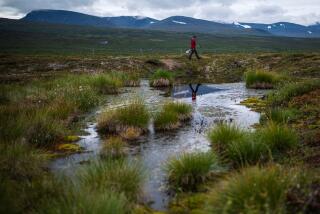ENVIRONMENT : Scientist Chilled by Evidence of Thaw in Alaska Permafrost
- Share via
JUNEAU, Alaska — A University of Alaska scientist says he has found disturbing evidence that the enormous sheet of frozen ground underlying about 85% of Alaska is slowly thawing, threatening the stability of homes, runways and highways across much of the state.
Tom Osterkamp of the university’s geophysical institute in Fairbanks has been studying the permafrost for more than two decades--and he has found that thawing already has begun in some areas, while in others the ice trapped in the soil is within one degree of melting.
“We may soon find ourselves in a very precarious position,” says Osterkamp, who uses sensors embedded in at least 40 wells that parallel the Trans- Alaska Pipeline running from the Prudhoe Bay oil fields in the far north to the southern port of Valdez.
If the trend continues, it could be particularly troubling for a broad belt that stretches across Alaska south of the Yukon River and includes Fairbanks, the state’s second-largest city. It is in that region, lying south of the famed Brooks Range that transects the state from east to west, that Osterkamp has detected the thawing.
In most of Alaska, particularly at higher latitudes or higher elevations, the ground remains permanently frozen. Individual grains of soil do not even touch each other, Osterkamp says, and are held apart by a thin layer of ice.
If the permafrost thaws, the ice melts, allowing the grains to compact. The surface slumps, causing highways and runways to buckle, foundations to crumble and even trees to topple.
Residents of Southern California who live in homes built on unstable hillsides can empathize with the problem. When the rains come to the Southland, the hills slide; when the permafrost thaws, the ground slumps.
Living with permafrost is a constant challenge for people like Jim Little, assistant maintenance director for Fairbanks’ Department of Transportation. Little has been battling to keep the area’s roads passable ever since he first got here in 1972.
“It was bad in 1972, and it’s bad now,” Little says.
Under the best of circumstances, highways and other structures built on frozen ground cause the soil to warm up, thawing the permafrost and undermining their own foundations. That can only get worse if Osterkamp’s findings signal a gradual warming across much of the state.
Little says that it has always been a mess, and to him it doesn’t seem any worse now than it was 23 years ago. He says the slight changes detected by Osterkamp may be too subtle to have accelerated the problems noticeably.
But Osterkamp is confident that if the trend he has detected continues, Little’s life will get a lot more complicated. Osterkamp drilled his research wells between 1976 and 1984, and the temperature in each well is measured every four hours. The northernmost wells have shown no signs of warming because the average temperature there remains well below freezing.
“But south of the Yukon River, every hole that we have shows a warming of anywhere between a half-degree to about a degree and a half,” he says.
In many areas, that is enough to cause the permafrost to begin to thaw, but Osterkamp is not certain why it is happening. One possible explanation is global warming from the so-called “greenhouse effect” caused by the release of carbon dioxide from the burning of fossil fuels. Many scientists believe that process is trapping heat in the Earth’s atmosphere.
But proving that global warming is indeed taking place has turned out to be one of the most evasive goals facing scientists, and Osterkamp’s work is not likely to resolve the issue.
Although convinced that his evidence shows the permafrost is melting, Osterkamp says reasons other than global warming could be the culprit. Fairbanks, for example, has had record snowfalls in recent years. The snow acts as an insulator, and it actually makes the soil warmer by protecting it from the frigid temperatures above.
If the thawing continues for several years, however, that would suggest the cause is a long-term phenomenon, probably global warming, he says.
More to Read
Sign up for Essential California
The most important California stories and recommendations in your inbox every morning.
You may occasionally receive promotional content from the Los Angeles Times.












